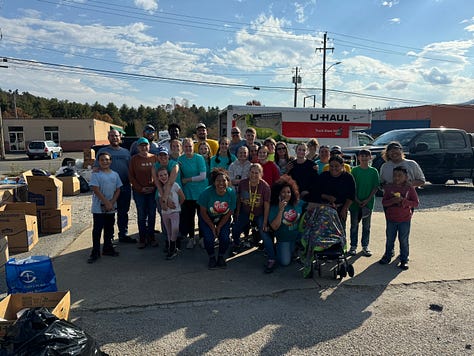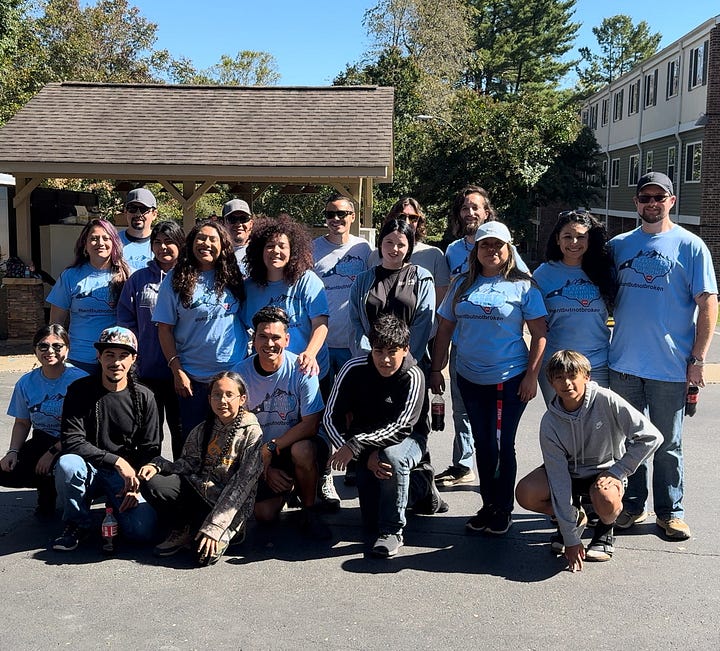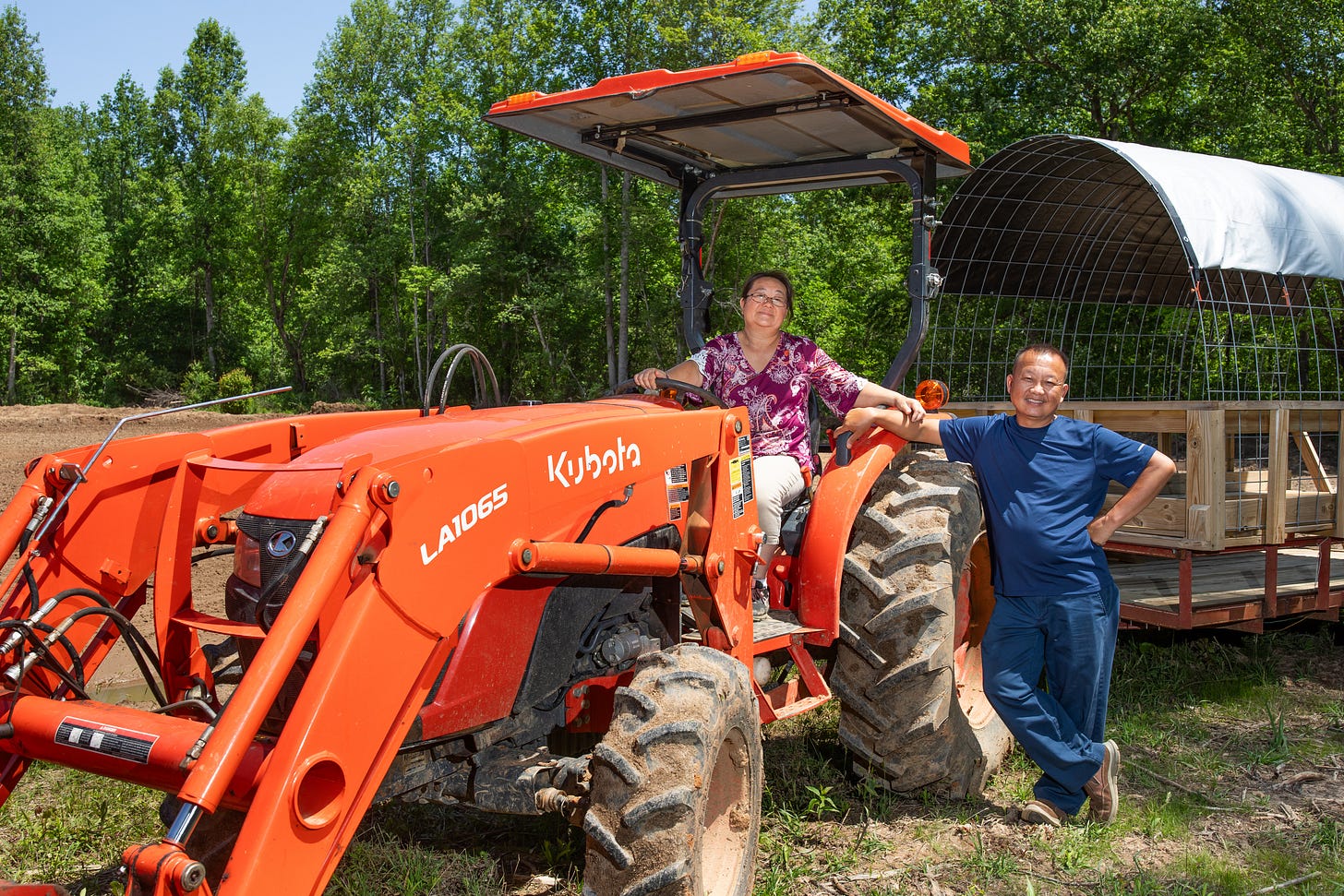Where Are All the Appalachians of Color in News Coverage of Hurricane Helene?
While Appalachia is home to a disproportionately high white population, the lack of media outlets covering Hurricane Helene's impact on Appalachians of color risks perpetuating outdated stereotypes.
A torrent of news coverage from regional and national outlets has focused on our mountain communities in the aftermath of Hurricane Helene. First-hand video reels and tales of heartbreak trickled out at first, but as power and cell reception were restored, reports flooded news feeds across the country with images of mudslides that had moved homes, terraformed riverbeds, and decimated bridges.
Several Appalachian communities had been nearly washed off the map.
Faces of people whose families have labored, loved, and lived in the Appalachian mountains for generations have been broadcast to millions of Americans, attempts to reflect the losses and emotional carnage that words cannot capture.
Stories filled social media platforms of people cutting their way through fallen trees and live electrical wires to free neighbors, good Samaritans trekking up mountains with horses, ATVs, and, even goats to deliver much-needed supplies to isolated Appalachians, and family members hiking several miles through tangled forests to check on loved ones.
But something essential has been missing from all this media coverage, becoming more pronounced as those murky, time-warped days have piled up.
Several days ago, a knowing friend and active resident of Morganton drew my attention to something I had only barely realized. Much of the broadcasted images and videos that have gained traction or priority airing continue to reinforce dated Appalachian tropes—specifically, that of the white, under-educated, country bumpkin whose mountain twang is simultaneously endearing and emblematic of a supposed backwoods ignorance.
“I don’t see the diversity of the area reflected in media,” she lamented to me, she a Black woman who has spent years educating others about the cultural diversity and history that’s often overlooked—or rather, marginalized—in the foothills. “How are those Hispanic families who are wary of government faring? How are Hmong elders who speak little English moving through this? Where are images of Black folks who were impacted? Is everyone who’s been affected plugged into recovery resources?”
I wasn’t sure, but she was right to raise these concerns: How have Appalachians of color been treated during this biblical disaster?
‘We Did Not See Color.’
Heavy arboreal debris and silt deposited by Hurricane Helene smothered vegetable fields across Lee’s One Fortune Farm’s acreage spread throughout McDowell, Burke, and Catawba Counties. A late fall harvest of beans and tomatoes not yet picked was decimated by the once-in-a-hundred-year flooding that carved through the foothills region during the final days of September, and what felt like to some, the Last Days.
Tou Lee and his wife, Chue Lee, were without power for five days as neighbors and deployed line workers cleared fallen oaks, poplars, sugar maples, and pine trees from downed powerlines. The Lees lost an entire diesel truck, which they say will have to be replaced.
All of this scattered material will have to be cleared before they can replant again. “The work will take much of the time away from our field prep and planting for the spring harvest,” Lee says. “The way it is looking, we will have a reduction for the fall-winter crop and there will be an impact on our harvest in the spring.”
As a result of widespread power outages, the fruits and vegetables they had already harvested for local markets were also lost.
Owners of One Fortune Farm, which employs sustainable farming practices free of synthetic herbicides and pesticides, the Lees are one household among a large network of Hmong families that have grown specialty produce and heirloom vegetables in our region since the 1980s.
The eastern half of these farms in Burke and Catawba Counties fared better than those closer to the Blue Ridge, he says, where massive trees, knocked over by 40 MPH winds, destroyed homes and flooding washed away family vehicles.
Amidst the devastation, Appalachians from diverse ethnic, racial, and economic backgrounds have come together to each other’s aid. Neighbors were being, well, neighborly.
“We did not see color, nor did we see anyone differently,” Lee remarks. “We all had needs, and we all shared losses. We also mourned and cried for those who lost loved ones. Of course, the news network will show white people on TV. This area is largely white and folks like me are a very small group. However, whether they are white or color, each one does a great job of representing our plight as a whole and we are glad to have our nation know and see what is happening here.”
Building Bridges Between All Cultures in Appalachia
Sandra N. Aguirre was born in Comayagua, Honduras in 1983, but moved to Morganton in the 1990s with her mother and siblings. Leaving behind extended kin and friends and learning a new language at an older age were just a couple of challenges her family has faced, but she remains grateful.
“I am so thankful to God and my mother, Digna Brittain, for giving us the chance to have better opportunities in this country,” she says. “My mom worked three jobs and always showed perseverance in everything she did. She constantly expressed to us the importance of studying and gaining knowledge so that opportunities would open up for us.”
After graduating from Freedom High School, Aguirre would earn degrees in paralegal technology and criminal justice and, later, a master’s in public administration. In her 23 years as a paralegal, she has consistently advocated not only for “women and men who suffer from domestic violence,” she says, but has worked to overcome the cultural barriers that keep Appalachian communities divided, including those in the foothills. “My focus is not only to support but help in any way, inform and build bridges between all cultures.”





She has been impressed by the recovery efforts she has witnessed, despite the social obstacles that remain. This level of environmental devastation is unfamiliar territory for the region, but gives us an opportunity to show our true character.
“We're all doing the best we can,” Aguirre continues. “I think that externally it is noticeable that the aid is not reaching all places evenly. I don't think this is happening on purpose. I think some of the biggest barriers are language, transportation in some places, and communication. I believe that as a community we are doing what we can do. We, the people, have come together and have joined forces to rebuild our affected communities. It’s amazing the love and support we are receiving not just from local groups but from out-of-state organizations, churches, and individuals.”
‘I Have Always Known This About Appalachian People.’
Now, whether the presumed uneven distribution of relief aid and narrowed news coverage is due to subconscious biases regarding who is truly Appalachian or merely due to coincidental circumstances, it’s difficult to say. And, to be fair, western North Carolina does have a disproportionately high white population.
Per the 2020 U.S. Census, 79.5 percent of Burke and 86 percent of McDowell residents identify as white, and the North Carolina counties further up the mountain hit harder by Hurricane Helene are even less diverse, with Yancey at 91.3 percent and Mitchell at 91.6 percent.
Regardless, tropes about mountain people persist. But the thing with stereotypes is they tend to fall apart when you spend more time on the ground, where things are messy, and the mud begins to cake on your boots real quick.
Our region is still more diverse than media selections typically portray.
Cultures are living, breathing things—not a static black-and-white image from the 1920s—and they are nurtured by the people doing the work in their communities. Our culture is evolving alongside hard-working Appalachians dedicated to aiding and supporting their neighbors in need. Regardless of skin color, family heritage, or how long they’ve called these mountains home.
“The stereotypes mainly come from those that have never set foot here and have never learned our customs and culture in the mountains,” explains Lee, who is also a full-time employee of a pharmaceutical company, in addition to running a farming business with his wife. “I have lived here almost all my life, and I am a part of this culture and these mountains. Stereotypes come from half-truths and a lack of knowledge.”
It’s a communitarian spirit that animates our culture. It’s been on full display throughout the past month as relief distribution centers have been filled to the brim with supplies and volunteers have freely given their time and resources to uplift those beaten down by Hurricane Helene, suddenly finding themselves in dire circumstances.
“In times of need in our community, our neighbors are the first to come over and lend a hand without reservations,” Lee continues. “It did not matter if you were white, Black, brown, or yellow. These are the folks who came and cut trees from daylight until dark, sometimes not having taken the time to eat or drink. We care for our fellow man, and we do not like to see suffering and destruction. I have always known this about Appalachian people. What I like for our nation to take from this disaster is, if people all over our nation are as charitable as folks here in Appalachia are, we will have a much stronger, kinder, and prosperous nation.”
When English Isn’t Your First Language
Despite this abundance of fellowship and goodwill, language barriers remain a major challenge for Appalachians of color seeking assistance, particularly for the elderly. English is the de facto language used by businesses and governments in the region, which means vital information about relief and assistance doesn’t always travel well.
Many aged Hmong residents, for instance, still farm and experienced significant crop loss, Lee notes. And they have few places to turn for help.
“The eventual problem comes from not being able to apply for assistance or grants due to the language barrier,” he explains. “Also, these applications and notices for funds are all online and our elders do not have much knowledge of the internet, nor do they know how to fill and give appropriate information on applications.”
These online forms are confusing enough when English is your first language, but that’s not the only issue. Some Appalachians of color experience trepidation with any government documents.
Among many of the people he has spoken with, Lee says there’s “a common distrust of filing for help.” Farmers worry they may have to “give up their work on the land and will not be allowed to grow crops in the future to earn an income if they get assistance from the government.”
He attributes this apprehension among Hmong residents to their history with authoritarian government.
“This distrust stems from having lived under communist rule in their past,” he says. “So many of these folks will just avoid any interactions with the government and quietly go back to clean and tend to their land. Our younger Hmong families reside mostly in the Hickory area and did not suffer many losses. Many did not even have power outages. The younger folks work in companies and clinics and did not lose income to the storm.”
Similar fears are also shared by Spanish-speaking members of our community who can’t read or write in English, hindering their understanding of which programs or assistance are available, Aguirre explains. Many are concerned that a “public assistance organization will find out that they are in this country undocumented.”
She believes greater diversity among staff representing state and government agencies can alleviate suffering and misunderstanding throughout our region, citing personal experiences she has had with “African Americans, Asians, and Latinos who have felt marginalized after this natural disaster.”
Aguirre is heavily involved in the community as both a co-founder of Latinos Aventureros (Latino Adventurers), a bilingual group of outdoor enthusiasts dedicated to helping everyone experience the joys of nature, and volunteer with Manos de Esperanza (Hands of Hope), an organization born after the disaster to provide essentials supplies, cut down trees, and help clean up after Hurricane Helene.
So she feels especially attuned to the needs of non-white Appalachians.
“As a community leader who has been working since the moment we learned of the damage this hurricane caused,” she says, “I have witnessed very difficult things and experienced the frustration of the community. These feelings are valid because we are experiencing something so out of the ordinary.”
People have been disheartened not knowing how and where to receive help. The lack of sufficient transportation has been ubiquitous. Plus, some bear the added burden and perennial fear that comes from “not having legal status,” she continues. “In particular, the Latino community is marginalizing itself because of that fear, afraid to ask for help since many think that because they are not legal they can be denied, treated badly, or end up being deported.”
In the coming weeks, as we continue to provide relief and assistance to our fellow Appalachians, let us not overlook the additional difficulties faced by the marginalized members of our community—those who are certainly among the poor in spirit and those who mourn.




A good reminder to always evaluate our personal biases.